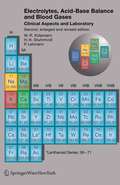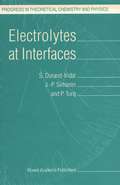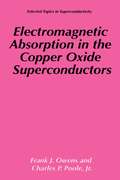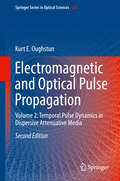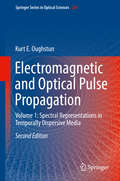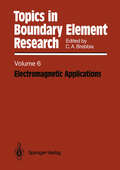- Table View
- List View
Electrolysis - Sodium Chloride Dissolved (tactile)
by RnibThis diagram first shows sodium chloride dissolved, then underneath shows molten sodium chloride.
Electrolytes: Supramolecular Interactions and Non-Equilibrium Phenomena in Concentrated Solutions
by Georgii Georgievich AseyevElectrolyte solutions play a key role in traditional chemical industry processes as well as other sciences such as hydrometallurgy, geochemistry, and crystal chemistry. Knowledge of electrolyte solutions is also key in oil and gas exploration and production, as well as many other environmental engineering endeavors. Until recently, a gap existed be
Electrolytes, Acid-Base Balance and Blood Gases: Clinical Aspects and Laboratory
by Wolf Rüdiger Külpmann H.-K. Stummvoll Paul LehmannThe first part of this book describes in a condensed manner the current state of diagnosis and treatment of disorders of electrolyte balance. It provides the physician with both a rapid aid to orientation at the bedside as well as a comprehensive insight into the pathophysiological relationships involved. A separate section deals with electrolytes in the urine. In the subsequent chapters, preanalysis and analysis of electrolytes are discussed.
Electrolytes, Acid-Base Balance and Blood Gases: Clinical Aspects and Laboratory
by Wolf Rüdiger Külpmann H.-K. Stummvoll Paul LehmannThis book examines the medical significance of electrolytes, acids, bases and blood gases, and how they are determined. It was written to provide physicians with a snapshot of the analytical testing of electrolytes, acids, bases and blood gases. In addition, it provides laboratory technicians with an overview of physiology and pathophysiology in these fields. The first part of the book provides a summary of the current status of diagnosis and therapy. It can be used for quick reference at the - tient’s bedside or to more thoroughly research pathophysiological int- dependencies. A separate section is dedicated to electrolytes in urine. The latter chapters discuss the preanalytical and analytical testing of electrolytes, the acid-base balance and blood gases, with special cons- eration for performing determination using ion-selective electrodes and carrier-bound reagents (“dry chemistry”). The final chapter discusses the quality assurance of the methods, with consideration for the new Guidelines of the German Bundesärztekammer (2001), which are p- sented in outline form.
Electrolytes at Interfaces (Progress in Theoretical Chemistry and Physics #1)
by S. Durand-Vidal J.-P. Simonin P. TurqThe aim of this book is to provide the reader with a modern presentation of ionic solutions at interfaces, for physical chemists, chemists and theoretically oriented experimentalists in this field. The discussion is mainly on the structural and thermodynamic properties, in relation to presently available statistical mechanical models. Some dynamic properties are also presented, at a more phenomenological level. The initial chapters are devoted to the presentation of some basic concepts for bulk properties: hydrodynamic interactions, electrostatics, van der Waals forces and thermodynamics of ionic solutions in the framework of a particular model: the mean spherical approximation (MSA). Specific features of interfaces are then discussed: experimental techniques such as in-situ X-ray diffraction, STM and AFM microscopy are described. Ions at liquid/air, liquid/metal and liquid/liquid interfaces are considered from the experimental and theoretical viewpoint. Lastly some dynamic (transport) properties are included, namely the self-diffusion and conductance of small colloids (polyelectrolytes and micelles) and the kinetics of solute transfer at free liquid/liquid interfaces.
Electrolytes for Electrochemical Supercapacitors (Electrochemical Energy Storage And Conversion Ser.)
by Cheng ZhongElectrolytes for Electrochemical Supercapacitors provides a state-of-the-art overview of the research and development of novel electrolytes and electrolyte configurations and systems to increase the energy density of electrochemical supercapacitors. Comprised of chapters written by leading international scientists active in supercapacitor research
Electrolytes for Lithium and Lithium-Ion Batteries (Modern Aspects of Electrochemistry #58)
by T. Richard Jow Kang Xu Oleg Borodin Makoto UeElectrolytes for Lithium and Lithium-ion Batteries provides a comprehensive overview of the scientific understanding and technological development of electrolyte materials in the last several years. This book covers key electrolytes such as LiPF6 salt in mixed-carbonate solvents with additives for the state-of-the-art Li-ion batteries as well as new electrolyte materials developed recently that lay the foundation for future advances. This book also reviews the characterization of electrolyte materials for their transport properties, structures, phase relationships, stabilities, and impurities. The book discusses in-depth the electrode-electrolyte interactions and interphasial chemistries that are key for the successful use of the electrolyte in practical devices. The Quantum Mechanical and Molecular Dynamical calculations that has proved to be so powerful in understanding and predicating behavior and properties of materials is also reviewed in this book. Electrolytes for Lithium and Lithium-ion Batteries is ideal for electrochemists, engineers, researchers interested in energy science and technology, material scientists, and physicists working on energy.
Electrolytic Production of Al–Si Alloys: Theory And Technology (Monographs In Electrochemistry Ser.)
by Dmitriy Pruttskov Aleksander Andriiko Aleksei KirichenkoElectrolytic Purification of Copper (tactile)
by RnibDiagram showing the equipment for electrolysis, and explaining the process of purifying copper, with textures used to differentiate objects, and labels.
Electrolyzed Water in Food: Fundamentals And Applications
by Tian Ding Deog-Hwan Oh Donghong LiuThis book provides fundamentals, highlights recent developments and offers new perspectives relating to the use of electrolyzed water (EW) as an emerging user- and environmental-friendly broad-spectrum sanitizer, with particular focus on the food industry. It addresses the generation, inactivation, pesticide degradation and safety of food by EW, illustrates the mechanism of the germicidal action of EW and its antimicrobial efficacy against a variety of microorganisms in suspensions. In addition, the sanitizing effects of combining EW with various chemical and physical sanitizing technologies have been evaluated, and recent developments and applications of EW in various areas including fruits and vegetables, meat, aquatic products, environment sterilization, livestock and agriculture has been described. The book can be a go-to reference book of EW for: (1) Researchers who need to understand the role of various parameters in its generation, the bactericidal mechanism of EW and its wide applications for further research and development; (2) Equipment producers who need comprehensive understanding of various factors (e.g. type of electrolyte, flow rates of water and electrolyte) which govern the efficacy of EW and developing its generators; (3) Food processors who need good understanding of EW in order to implement it in the operations and supervisors who need to balance the advantages and limitations of EW and ensuring its safe use.
Electromagnet (contracted)
by RnibA diagram of an electromagnet in a circuit to make a bell ring. This diagram contains a key for some of the diagrams labels.
An electromagnet (large print)
by RnibThis is a labelled side view of an electromagnet. There is a locator dot shown, which will be at the top left of the page when the image is the correct way up. The electromagnet is shown going across the centre of the page. There is a wire coiled many times around the magnet's core. Its two ends can be found down the page from the core at each side of the page. When an electric current is made to flow in the wire, it creates a magnetic field around the wire. The field is concentrated by the ferromagnetic (magnetic iron) core of the magnet.
An electromagnet (UEB contracted)
by RnibThis is a labelled side view of an electromagnet. There is a locator dot shown, which will be at the top left of the page when the image is the correct way up. The electromagnet is shown going across the centre of the page. There is a wire coiled many times around the magnet's core. Its two ends can be found down the page from the core at each side of the page. When an electric current is made to flow in the wire, it creates a magnetic field around the wire. The field is concentrated by the ferromagnetic (magnetic iron) core of the magnet.
An electromagnet (UEB uncontracted)
by RnibThis is a labelled side view of an electromagnet. There is a locator dot shown, which will be at the top left of the page when the image is the correct way up. The electromagnet is shown going across the centre of the page. There is a wire coiled many times around the magnet's core. Its two ends can be found down the page from the core at each side of the page. When an electric current is made to flow in the wire, it creates a magnetic field around the wire. The field is concentrated by the ferromagnetic (magnetic iron) core of the magnet.
Electromagnetic Absorption in the Copper Oxide Superconductors (Selected Topics in Superconductivity)
by Frank J. Owens Charles P. Poole Jr.In 1987 a major breakthrough occurred in materials science. A new family of materials was discovered that became superconducting above the temperature at which nitrogen gas liquifies, namely, 77 K or –196°C. Within months of the discovery, a wide variety of experimental techniques were brought to bear in order to measure the properties of these materials and to gain an understanding of why they superconduct at such high temperatures. Among the techniques used were electromagnetic absorption in both the normal and the superconducting states. The measurements enabled the determination of a wide variety of properties, and in some instances led to the observation of new effects not seen by other measu- ments, such as the existence of weak-link microwave absorption at low dc magnetic fields. The number of different properties and the degree of detail that can be obtained from magnetic field- and temperature-dependent studies of electromagnetic abso- tion are not widely appreciated. For example, these measurements can provide information on the band gap, critical fields, the H–T irreversibility line, the amount of trapped flux, and even information about the symmetry of the wave function of the Cooper pairs. It is possible to use low dc magnetic field-induced absorption of microwaves with derivative detection to verify the presence of superconductivity in a matter of minutes, and the measurements are often more straightforward than others. For example, they do not require the physical contact with the sample that is necessary when using four-probe resistivity to detect superconductivity.
Electromagnetic Acoustic Transducers: Noncontacting Ultrasonic Measurements using EMATs (Springer Series in Measurement Science and Technology)
by Masahiko Hirao Hirotsugu OgiThis second edition provides comprehensive information on electromagnetic acoustic transducers (EMATs), from the theory and physical principles of EMATs to the construction of systems and their applications to scientific and industrial ultrasonic measurements on materials. The original version has been complemented with selected ideas on ultrasonic measurement that have emerged since the first edition was released. The book is divided into four parts: PART I offers a self-contained description of the basic elements of coupling mechanisms along with the practical designing of EMATs for various purposes. Several implementations to compensate for EMATs’ low transfer efficiency are provided, along with useful tips on how to make an EMAT. PART II describes the principle of electromagnetic acoustic resonance (EMAR), which makes the most of EMATs’ contactless nature and is the most successful amplification mechanism for precise measurements of velocity and attenuation. PART III applies EMAR to studying physical acoustics. New measurements have emerged with regard to four major subjects: in situ monitoring of dislocation behavior, determination of anisotropic elastic constants, pointwise elasticity mapping (RUM), and acoustic nonlinearity evolution. PART IV deals with a variety of individual issues encountered in industrial applications, for which the EMATs are believed to be the best solutions. This is proven by a number of field applications.
Electromagnetic Actuation and Sensing in Medical Robotics (Series in BioEngineering)
by Hongliang Ren Jinji SunThis book highlights electromagnetic actuation (EMA) and sensing systems for a broad range of applications including targeted drug delivery, drug-release-rate control, catheterization, intravitreal needleless injections, wireless magnetic capsule endoscopy, and micromanipulations. It also reviews the state-of-the-art magnetic actuation and sensing technologies with remotely controlled targets used in biomedicine.
Electromagnetic Analysis and Design in Magnetic Resonance Imaging
by Jianming JinThis book presents a comprehensive treatment of electromagnetic analysis and design of three critical devices for an MRI system - the magnet, gradient coils, and radiofrequency (RF) coils. Electromagnetic Analysis and Design in Magnetic Resonance Imaging is unique in its detailed examination of the analysis and design of the hardware for an MRI system. It takes an engineering perspective to serve the many scientists and engineers in this rapidly expanding field.Chapters present:an introduction to MRIbasic concepts of electromagnetics, including Helmholtz and Maxwell coils, inductance calculation, and magnetic fields produced by special cylindrical and spherical surface currentsprinciples for the analysis and design of gradient coils, including discrete wires and the target field method analysis of RF coils based on the equivalent lumped-circuit model as well as an analysis based on the integral equation formulationsurvey of special purpose RF coilsanalytical and numerical methods for the analysis of electromagnetic fields in biological objectsWith the continued, active development of MRI instrumentation, Electromagnetic Analysis and Design in Magnetic Resonance Imaging presents an excellent, logically organized text - an indispensable resource for engineers, physicists, and graduate students working in the field of MRI.
Electromagnetic Analysis and Design in Magnetic Resonance Imaging (Biomedical Engineering Ser.)
by Jianming JinThis book presents a comprehensive treatment of electromagnetic analysis and design of three critical devices for an MRI system - the magnet, gradient coils, and radiofrequency (RF) coils. Electromagnetic Analysis and Design in Magnetic Resonance Imaging is unique in its detailed examination of the analysis and design of the hardware for an MRI system. It takes an engineering perspective to serve the many scientists and engineers in this rapidly expanding field.Chapters present:an introduction to MRIbasic concepts of electromagnetics, including Helmholtz and Maxwell coils, inductance calculation, and magnetic fields produced by special cylindrical and spherical surface currentsprinciples for the analysis and design of gradient coils, including discrete wires and the target field method analysis of RF coils based on the equivalent lumped-circuit model as well as an analysis based on the integral equation formulationsurvey of special purpose RF coilsanalytical and numerical methods for the analysis of electromagnetic fields in biological objectsWith the continued, active development of MRI instrumentation, Electromagnetic Analysis and Design in Magnetic Resonance Imaging presents an excellent, logically organized text - an indispensable resource for engineers, physicists, and graduate students working in the field of MRI.
Electromagnetic and Optical Pulse Propagation: Volume 2: Temporal Pulse Dynamics in Dispersive Attenuative Media (Springer Series in Optical Sciences #225)
by Kurt E. OughstunIn two volumes, this book presents a detailed, systematic treatment of electromagnetics with application to the propagation of transient electromagnetic fields (including ultrawideband signals and ultrashort pulses) in dispersive attenuative media. The development in this expanded, updated, and reorganized new edition is mathematically rigorous, progressing from classical theory to the asymptotic description of pulsed wave fields in Debye and Lorentz model dielectrics, Drude model conductors, and composite model semiconductors. It will be of use to researchers as a resource on electromagnetic radiation and wave propagation theory with applications to ground and foliage penetrating radar, medical imaging, communications, and safety issues associated with ultrawideband pulsed fields. With meaningful exercises, and an authoritative selection of topics, it can also be used as a textbook to prepare graduate students for research. Volume 2 presents a detailed asymptotic description of plane wave pulse propagation in dielectric, conducting, and semiconducting materials as described by the classical Lorentz model of dielectric resonance, the Rocard-Powles-Debye model of orientational polarization, and the Drude model of metals. The rigorous description of the signal velocity of a pulse in a dispersive material is presented in connection with the question of superluminal pulse propagation. The second edition contains new material on the effects of spatial dispersion on precursor formation, and pulse transmission into a dispersive half space and into multilayered media. Volume 1 covers spectral representations in temporally dispersive media.
Electromagnetic and Optical Pulse Propagation: Volume 1: Spectral Representations in Temporally Dispersive Media (Springer Series in Optical Sciences #224)
by Kurt E. OughstunThis volume presents a detailed, rigorous treatment of the fundamental theory of electromagnetic pulse propagation in causally dispersive media that is applicable to dielectric, conducting, and semiconducting media. Asymptotic methods of approximation based upon saddle point methods are presented in detail.
Electromagnetic and Optical Pulse Propagation 1: Spectral Representations in Temporally Dispersive Media (Springer Series in Optical Sciences #125)
by Kurt E. OughstunThis volume presents a detailed, rigorous treatment of the fundamental theory of electromagnetic pulse propagation in causally dispersive media that is applicable to dielectric, conducting, and semiconducting media. Asymptotic methods of approximation based upon saddle point methods are presented in detail.
Electromagnetic and Optical Pulse Propagation 2: Temporal Pulse Dynamics in Dispersive, Attenuative Media (Springer Series in Optical Sciences #144)
by Kurt E. OughstunElectromagnetic & Optical Pulse Propagation presents a detailed, systematic treatment of the time-domain electromagnetics with application to the propagation of transient electromagnetic fields (including ultrawideband signals and ultrashort pulses) in homogeneous, isotropic media which exhibit both temporal frequency dispersion and attenuation. The development is mathematically rigorous with strict adherence to the fundamental physical principle of causality. Approximation methods are based upon mathematically well-defined asymptotic techniques that are based upon the saddle point method. A detailed description is given of the asymptotic expansions used. Meaningful exercises are given throughout the text to help the reader‘s understanding of the material, making the book a useful graduate level text in electromagnetic wave theory for both physics, electrical engineering and materials science programs. Both students and researchers alike will obtain a better understanding of time domain electromagnetics as it applies to electromagnetic radiation and wave propagation theory with applications to ground and foliage penetrating radar, medical imaging, communications, and the health and safety issues associated with ultrawideband pulsed fields. Volume 2 presents a detailed asymptotic description of plane wave pulse propagation in dielectric, conducting, and semiconducting materials as described by the classical Lorentz model of dielectric resonance, the Rocard-Powles-Debys model of orientational polarization, and the Drude model of metals. The rigorous description of the signal velocity of a pulse in a dispersive material is presented in connection with the question of superluminal pulse propagation.
Electromagnetic and Quantum Measurements: A Bitemporal Neoclassical Theory
by Tore Wessel-BergIt is a pleasure to write a foreword for Professor Tore Wessel-Berg's book, "Electromagnetic and Quantum Measurements: A Bitemporal Neoclassical Theory." This book appeals to me for several reasons. The most important is that, in this book, Wessel-Berg breaks from the pack. The distinguished astrophysicist Thomas Gold has written about the pressures on scientists to move in tight formation, to avoid having their legs nipped by the sheepdogs of science. This book demonstrates that Wessel-Berg is willing to take that risk. I confess that I do not sufficiently understand this book to be able to either agree or disagree with its thesis. Nevertheless, Wessel-Berg makes very cogent arguments for setting out on his journey. The basic equations of physics are indeed time-reversible. Our experience, that leads us to the concept of an "arrow of time," is derived from macro scopic phenomena, not from fundamental microscopic phenomena. For this reason, it makes very good sense to explore the consequences of treating microscopic phenomena on the assumption that forward time and backward time are equal.
Electromagnetic Applications (Topics in Boundary Element Research #6)
by Carlos A. BrebbiaGeneral Applications of BEM to electromagnetic problems are comparatively new although the method is ideally suited to solve these problems, which usually involve unbounded domains. The present volume comprises contributions by eminent researchers working on applications of boundary elements in electromagnetic problems. The volume deals with the solutions of Maxwell's equation for three-dimensional as well as two-dimensional cases. It also discusses combination of BEM with FEM particularly in the case of saturated media. Some chapters specifically deal with the design of electromagnetic devices. The book is essential reading to those engineers and scientists, who are interested in the state of the art for electrical and electromagnetic application of boundary elements. It is also an important reference for those engineers who are working on the design of electromagnetic components many of which can be advantageously carried out using BEM.



